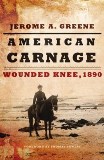It was 125 years ago, on December 29, 1890, that U.S. Army soldiers killed numerous Lakota Native Americans, including many women and children, near the Wounded Knee Creek in South Dakota. This is sometimes referred to as the last major event in the “Indian Wars” period. The Lakota were no longer living free, mostly confined to reservations and depending on the U.S. Government for support due to drought and crop failure. They had suffered war, diseases, loss of game and land, and reduced rations. The buffalo herds had been decimated. Any land found to have value was taken. Even the Black Hills, acknowledged as belonging to the Sioux by the Treaty of 1868, was coveted–and encroached upon–for gold, which, in addition to pressures for settlers and railroads, resulted in additional agreements that reduced the Sioux reservation land further. There had been many broken promises and treaties. The Ghost Dance, part of the spiritual vision of a Paiute “messiah” named Wovoka, had been adopted by some of the Lakota. In this vision, if Natives lived appropriately and performed the Ghost Dance, ‘whites’ and their effects would disappear from Native land; Native Americans’ ancestors would be resurrected; and the buffalo herds and other game would be restored. Because of concerns that the dancing might be a war dance leading to an uprising, reservation agents were ordered to stop it. Unable to do so, the recently-assigned and inexperienced agent at the Pine Ridge Reservation, Daniel Royer, sent a telegraph to Washington, D.C. on November 15 asking for military support:
Indians are dancing in the snow and are wild and crazy. I have fully informed you that employes and Government property at this agency have no protection and are at the mercy of these dancers. Why delay by further investigation? We need protection, and we need it now. The leaders should be arrested and confined in some military post until the matter is quieted, and this should be done at once.
Some of the newspaper coverage also supported fear of the Ghost Dance. Finally, several Army units were ordered to the area, the largest massing of soldiers since the Civil War. Chief Big Foot (aka Spotted Elk) was moving a group of less than 400 to the Pine Ridge agency, but the move was thought to be an attempt to join up with other hostile Natives by the Army. Army units surrounded them and sought to disarm them. After several weapons had been surrendered, a shot was fired, although it is not clear by whom, and it resulted in the massacre, which for some time was called a battle for which several soldiers received the Congressional Medal of Honor. Due to the placement of the Army units, the soldiers also injured or killed each other in crossfire. Those that saw the scene later found the bodies of women and children who had been fleeing and were chased down. In 1990, for the 100th anniversary, the U.S. Congress passed a resolution that expressed “deep regret” for the Wounded Knee massacre and supported the creation of a memorial.
 You can learn much more, and Andersen Library can help. Read books such as American carnage: Wounded Knee, 1890 (3rd-floor Main Collection, E83.89 .G74 2014) and Wovoka and the ghost dance (3rd-floor Main Collection, E99.P2 W617 1997). The Annual report of the commissioner of Indian affairs, for the year 1891 (volume 1) is available online, and in addition to the section “Reports of agents in Wisconsin, pp. 463-475”, read “The ‘Messiah Craze,’ pages 123-127” and pages 127-145 for more about the “Troubles Among the Sioux.” Read articles such as “Wounded Knee: Healing the Wounds of the Past” (Indian Country, December 29, 2015), “In memory of the Chief Big Foot massacre: The Wounded Knee survivors and the politics of memory” (Western Historical Quarterly, 2015, vol.46:no.1, pp.31-51), and “The evolution of a massacre in newspaper depictions of the Sioux Indians at Wounded Knee, 1876-1891” (Atlanta Review of Journalism History, 2015, vol.12, pp.38-64).
You can learn much more, and Andersen Library can help. Read books such as American carnage: Wounded Knee, 1890 (3rd-floor Main Collection, E83.89 .G74 2014) and Wovoka and the ghost dance (3rd-floor Main Collection, E99.P2 W617 1997). The Annual report of the commissioner of Indian affairs, for the year 1891 (volume 1) is available online, and in addition to the section “Reports of agents in Wisconsin, pp. 463-475”, read “The ‘Messiah Craze,’ pages 123-127” and pages 127-145 for more about the “Troubles Among the Sioux.” Read articles such as “Wounded Knee: Healing the Wounds of the Past” (Indian Country, December 29, 2015), “In memory of the Chief Big Foot massacre: The Wounded Knee survivors and the politics of memory” (Western Historical Quarterly, 2015, vol.46:no.1, pp.31-51), and “The evolution of a massacre in newspaper depictions of the Sioux Indians at Wounded Knee, 1876-1891” (Atlanta Review of Journalism History, 2015, vol.12, pp.38-64).
Please ask a librarian (via email, chat, phone 262.472.1032 or visit the Reference Desk) for assistance with finding materials.
 Andersen Library is a federal and Wisconsin depository library with federal and state government documents on a variety of current and relevant issues available to you in various formats (print, DVD/CD-ROM, online). Check out your government at Andersen Library!
Andersen Library is a federal and Wisconsin depository library with federal and state government documents on a variety of current and relevant issues available to you in various formats (print, DVD/CD-ROM, online). Check out your government at Andersen Library!
